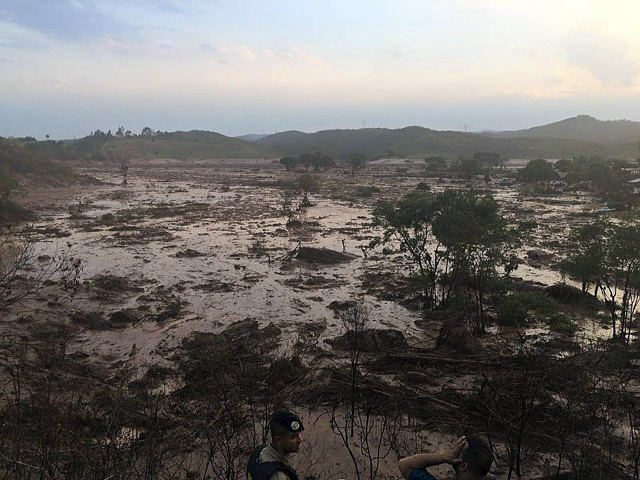SUMMARY
This is AI generated summarization, which may have errors. For context, always refer to the full article.

MARIANA, Brazil – Brazilian rescuers searched frantically for survivors Friday, November 6, after burst dams unleashed a torrent of toxic red sludge that killed at least 17 people and destroyed a village.
The mudslide erupted Thursday from a reservoir of waste at the partly Australian-owned iron ore and minerals mine in southeastern Brazil, ripping the roofs off houses and leaving villagers clinging to their roofs.
“It was like a horror movie,” said one anonymous survivor quoted by the Globo news website. “People were running and yelling that it was the end of the world. Water was coming from all sides.”
Firefighters searched the ruins of Bento Rodrigues, a village of some 600 people near the southeastern city of Mariana in the historic mining region of Minas Gerais.
The cause of the disaster was not confirmed, but one seismological expert said small tremors had been detected in the area on Thursday.
By Thursday night, there were 17 people officially confirmed killed and 50 injured, “but more bodies have been found”, said Adao Severino Junior, the fire chief in Mariana.
He told AFP there could be more than 40 people missing but he would not release a new death toll until relatives of the victims were notified.
“There is no way to survive under that material,” he said of the mudslide.
‘Small quakes detected’
Most of the village’s inhabitants work for Samarco, the company jointly owned by BHP Billiton of Australia and Vale of Brazil, which operates the site where the disaster struck.
Samarco said 13 of its employees were missing in the disaster.
It said the causes of the rupture were not known.
George Sandi of the Brazilian seismological observatory told CBN radio that two small earthquakes had been registered in the region on Thursday afternoon.
The surface area of mud held back by one of the burst dams, the Fundao, was equivalent to 10 football fields, said Ronaldo Bento, leader of the local miners’ union.
That dam was staffed by 25 workers and contained “toxic mud consisting of mineral waste,” he said.
Hundreds of rescuers worked through the night largely in the dark after the mudslide toppled electrical pylons, cutting off power.
Bulldozers were busy clearing blocked roads so that rescue vehicles could reach the site, said a civil defense spokesman who identified himself as Sergeant Damaceno.
He said 122 Bento Rodrigues homes were buried in mud, while 150 local residents spent the night at a shelter in Mariana, some 23 kilometers (14 miles) away.
Fleeing over rooftops
Fifteen-year-old Marcos Junior de Souza told the Folha de Sao Paulo newspaper that he fled his home after a neighbor shouted that a dam had burst.
“All my life I had heard people saying that it was going to break but I never thought much of it until the water flooded my house,” he was quoted as saying.
“I climbed out the window, climbed onto the roof and jumped from one roof to another” to take refuge on higher ground, he said.
He was being housed in a gymnasium in Mariana, where residents donated mattresses and bottles of water for the stricken villagers.
Mariana and the nearby village of Ouro Preto sent firefighters and ambulances.
Brazil’s President Dilma Rousseff offered the governor of Minas Gerais assistance from the army and the national civil defense corps.
The president of Samarco, Ricardo Vescovi, said the company was “mobilizing absolutely all necessary efforts” to help people struck by the disaster.
“We are also not sparing efforts to contain the environmental damage,” he said in a video message.
Minas Gerais has been Brazil’s main mining hub since the 16th century. First came gold, then mining of iron ore, other minerals and semi-precious stones. – Douglas Magno, AFP/Rappler.com
Add a comment
How does this make you feel?
There are no comments yet. Add your comment to start the conversation.